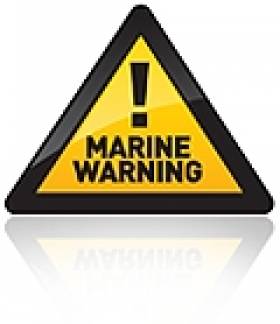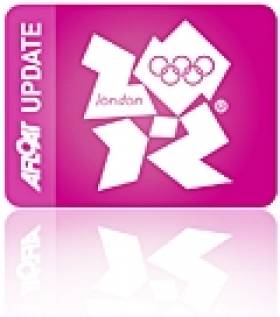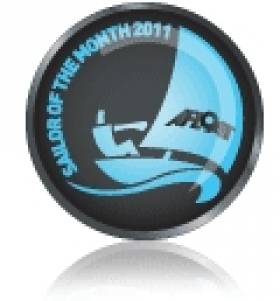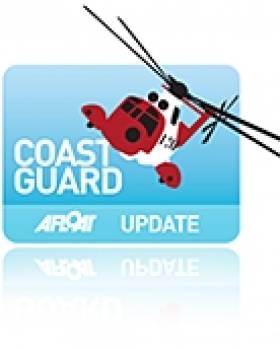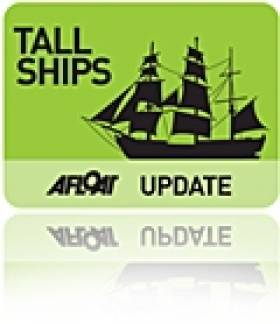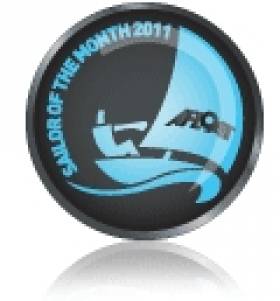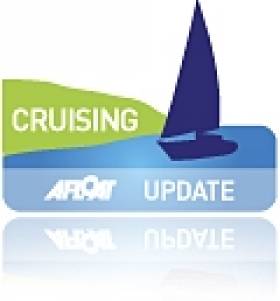Displaying items by tag: sailor
Is Your Lifejacket Safe? Free Test at Dun Laoghaire Marina this Sunday
Is your lifejacket safe? That's the question the RNLI is asking sailors this Sunday at Dun Laoghaire marina. And If last year's clinic's statistics is anything to go by then the answer is most likely no.
Over 90% of lifejackets tested at Ireland's two biggest sailing centres failed simple checks carried out by the Royal National Lifeboat Institute in 2010. From 91 jackets tested in Cork and Dublin, 83 failed a free inspection. More here.
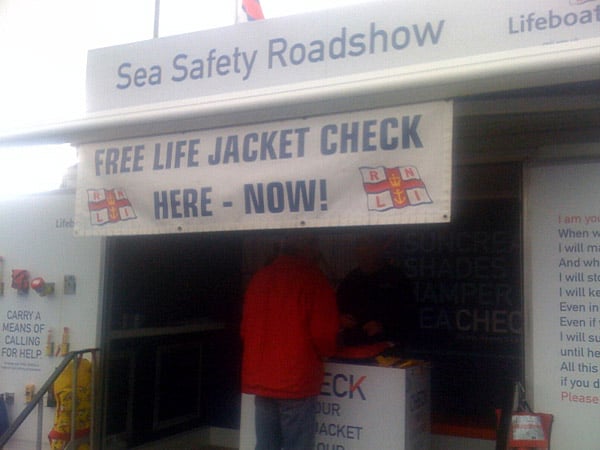
This year the Dun Laoghaire marina initiative with the RNLI aims to get more boat owners, sailors and crews to avail of the free test carried out at the clinic.
The Dun Laoghaire offshore lifeboat will be in the marina's Emergency Berth to allow you to get an close up inspectionand there will be RNLI personnel available to discuss any safety advice or search and rescue questions you may have.
The RNLI will also be taking bookings for a free onboard visit to your boat by the local Sea Safety Officer.
Will your lifejacket work when you need it? Do you know how to make sure it's a correct fit? Do you know how to look after it? All these questions and more will be answered by trained RNLI Sea Safety advisors.
You can learn the importance of choosing, fitting and the maintenance of a lifejacket from 11am to 4pm in Dun Laoghaire at the Lifejacket Clinic with RNLI Sea Safety Team. Likely topics as follows:
Which one?
There are many different types of lifejackets and buoyancy aids on the market. We can help you decide which one is best suited to your needs.
What size?
Size matters! A lifejacket or buoyancy aid will only work properly if it is properly fitted. We can show you how to adjust the lifejacket to a proper fit and why crotch straps are an essential part of the kit.
Looking after it.
It is essential to look after the buoyancy aid or lifejacket properly. With proper maintenance and regular servicing, your lifejacket will last longer and you can ensure it remains reliable. At our lifejacket clinic you can find out what checks to carry out on your lifejacket and how to care for it.
When to wear it?
RNLI volunteer crew wear a properly fitting lifejacket with crotch straps whenever the go afloat on the lifeboat, no matter what the weather. The RNLI believes that lifejackets are useless unless worn. All too often, RNLI crews recover people from the water who were not wearing lifejackets, and have not survived. A lifejacket can buy you time for the rescue services to get to you.
Britain's Olympian Ben Ainslie Goes Extreme!
Ainslie recently competed in the Olympic test regatta in Weymouth and will return to his Olympic ambitions at the ISAF World Champions and Finn Gold Cup in Perth, Australia at the end of year. In the meantime, he has selected the opportunity to step from one hull to two in the Extreme 40 class, and step in to the cauldron of hot competition in the Extreme Sailing Series. Multihull sailing may have been around for a few decades, but the current trend puts the multihull platform firmly at the forefront of professional sailing whether it is the America's Cup, the new MOD70 circuit, round the world speed records (fully crewed or solo) or the Extreme Sailing Series – the ground-breaking circuit that has pioneered the Stadium sailing format since its creation in 2007 – and now a global circuit visiting three continents. "I'm looking forward to competing in the Extreme Sailing Series," said Ainslie. "I've had the chance to watch some of the previous events, the sailing is very close and a great spectacle. This will be my first competitive experience of the circuit and it's an exciting prospect."
But Ainslie will feel the pressure of stepping into a new multihull class: "There is definitely a bit of pressure stepping on the boat at this stage in the Series, and I think it is going to be a lot about me not letting the guys down as they have been doing a great job so far this year," said Ainslie. "We have just a couple of days training in Trapani before our first event together, so it is going to be tough going in cold, but hopefully I can pick it up quickly and we can get some good results."
Ben Ainslie will be replacing French skipper Sidney Gavignet following his move to Oman Sail's new Multi One Design 70 campaign. The 'Oman Air' Extreme 40 team lie 8th out of 11 in the overall 2011 Extreme Sailing Series rankings and Ainslie will be racing with the regular crew of bowman Nasser Al Mashari, tactician Kinley Fowler and trimmer David (Freddie) Carr.
Double Olympic gold medalist and skipper of Red Bull Extreme Sailing, Roman Hagara, commented: "I'd like to welcome Ben Ainslie to the circuit. We both have a big Olympic background and know how to sail under pressure. This is the right place for him to show his skills on big multihulls. For sure we will have some great racing going on against each other in the coming events."
Paul-Campbell James, winning skipper on The Wave, Muscat in the 2010 Extreme Sailing Series, now skipper of the Italian entry Luna Rossa is looking forward to the next Act in Trapani (Sicily) where the Italian team can expect some good 'home' support, commented: "It's great to have Ben in the fleet and in the winning boat from 2009. I've never raced him before and am fascinated to see how he gets on."
Act 7 of the 2011 Extreme Sailing Series will be staged in Trapani on the island of Sicily starting on the 14th September with Stadium racing staged over the 16th-18th September.
Kieran Cotter and Jerry Smith Named Sailors of the Month for August
When Rambler's canting keel snapped off on the evening of Monday August 15th shortly after this mega-machine had rounded the Rock, she was powering at full speed towards the turning buoy, crashing into the lumpy seas which often arise where the steep land juts into the open ocean.

Kieran Cotter and the crew of the Baltimore lifeboat at the capize site. Photo: Thierry Martinez
The catastrophe was total and very sudden. The giant racer completely inverted every bit as quickly as the smallest of racing dinghies. The changeover, from being a highly tuned performer on track for success, into the inverted hell of exploding water, strangling ropes and jagged breaking gear, was at the least totally disorienting, and could have caused panic in less seasoned sailors.

The Lifeboat rescue from the upturned hull. Photo: Team Phaedo
Despite the difficulty of clambering onto the ultra-smooth underside of the huge hull, fifteen of the crew managed to get themselves up to the minimal handhold of the dagger board. But five of those who had been below – some of them off watch asleep – had drifted away from the boat after the monumental struggle of escaping from a small world turned upside down.
The five in the water roped themselves together, but things had taken an ominous turn, as the mist in which the big boat had rounded the Fastnet had now thickened into fog. For a crucial period, visibility was virtually nonexistent as other boat raced past nearby at high speed. And although some emergency radio beacons had automatically activated, the picture was confused with night drawing on.

Drifting crew are rescued. Photo: Team Phaedo
Time was of the essence – even in summer these waters can quickly induce hypothermia. Several agencies were now involved in the rescue, and skilled use of technology narrowed the search area, though in the sea conditions the stricken boat and crew were frequently invisible.
It was the Baltimore lifeboat with Kieran Cotter in command which was first on the scene. Taking off the crew was a challenge, but all fifteen on the upturned Rambler were safely rescued, though an impact between lifeboat and white hull resulted in a streak of lifeboat blue on the yacht which was to be immortalised as "Kieran's kiss".
But that was later, not until after a needle-in-a-haystack search found the other five adrift together in the water, with one already on the edge of coma. They were found by the lifeboat deputy mechanic Jerry Smith, on patrol with a Fastnet Race film crew in his dive boat Wave Chieftain. It was a miracle.
Next morning safely in Baltimore, the weather was already well improved. The previous night's conditions seemed like a nightmare. In calm summery conditions two days later, the Rambler hull was righted off Barley Cove and towed to Baltimore. She'll be restored to full racing trim by Cookson's in New Zealand, presumably with modifications to the design and specification for the canting keel. But that's another day's work. Today, we celebrate the achievement of Kieran Cotter and Jerry Smith, whose seamanship provided the successful focus for a network of rapid work by skilled technologists ashore.
Coverage of the rescue appears in Afloat's Rolex Fastnet Race page
Who Will Be July's Sailor of the Month?
Overdue Sailor Located
He had last communicated with his brother yesterday morning when he departed Peel, Isle of Man on passage to Ardglass in Northern Ireland.
He had declared that he would call his brother on his arrival at 21.00 yesterday evening. He did not make that call and his brother alerted the authorities this morning.
Belfast Coastguard called out the Southdown and Bangor Coastguard rescue teams to undertake a search of harbours, marinas and anchorages. Other harbours and marinas are being checked around the Isle of Man and the Liverpool area.
At 02.37pm this afternoon, the Isle of Man authorities managed to get a fix on his mobile phone on one of the rare occasions that it was switched on which indicated that he was still in the area of the Isle of Man. The coordination of the incident was transferred to Liverpool Coastguard, who requested the launch of the Port Erin and Port St Mary RNLI lifeboats who eventually located him 6 miles west of Niarbyl, Isle of Man.
After they checked he was OK and determining what communications equipment he had, which in this case was a mobile phone that had gone flat and a hand held VHF radio that was turned down, the sailor was confident that he would continue his passage to Ardglass.
Su Daintith, Watch Manager, Liverpool Coastguard said:
We are pleased that this sailor has been located safe and well and hope that he learns from this sailing experience that good communications and knowing how to use them are a vital part of equipment on any sailing trip.
You can always register your vessel with our small yacht and boat safety scheme CG66 and we would advise sailors that they can always let us know their passage plan.
Tall Ships 2011: Young Sailors 'Buoyed' with their Successes
Not only has their ship, The Moosk been placed third in class in the first leg of the race, but they were awarded the youngest crew trophy and won their skipper's weight in food and drink having been the first 2011 tall ship to arrive at Unst.
Eighteen of the St Budeaux School's 14-19 year olds have been involved in the international event which started in Waterford, Ireland and included ports of call at Greenock, Scotland and Lerwick in the Shetland Isles, continuing to Stavanger in Norway before finally dropping anchor at Halmstad in Sweden at the beginning of August.
The 18 students who successfully completed a rigorous selection before finally becoming crew for a section of the race on the tall ship Moosk were split into three groups.
The first six sailed from Plymouth to Waterford where six more Marine Academy students took over and raced in the first leg, Race One, from Waterford to Greenock. Once in Greenock, the crew changed again and the final six students sailed to Lerwick before returning home this weekend.
The young sailors are buoyed up with their successes.
In their latest messages on Facebook they say: "Wahoo just arrived in Lerwick, we've had an amazing time already. We've been to Unst and rounded Mukkle Flugga, the most northern point in Britain. We won the Captain's Weight in Unst - proud - and had a parade with Vikings. All in all it's been amazing so far."
Marine Academy Plymouth is planning a celebration evening in September for the students who joined hundreds of other youngsters crewing ships from Russia, Belgium, Germany, Sweden, Lithuania, Poland, Norway, Denmark, Colombia, Spain and France.
Helen Mathieson principal at Marine Academy Plymouth said: "The success of all our young people taking part in the fantastic event which is the Tall Ships Race is a very fitting end to the Marine Academy Plymouth's first year.
"All the students who have taken part have learned so much - about themselves, what they can achieve and how they can make success happen by working with others. All of them have been part of winning teams and have felt the joy of making it happen for themselves; their horizons have been widened by the whole experience."
Mid-Week Wrap up: Fireballs, Lasers, Three Peaks, Calves Week, VOR and Life Saving Honours
An Irish debutant leads the fleet after four days of competition in the Three Peaks Yacht Race. Last night Glen Ward's crew were climbing Ben Nevis.
Half the country is heading for the Tall Ships.
400 are now expected for next week's Volvo Dun Laoghaire Regatta.
There's only a month to Calves week in West Cork. The race programme (plus a sponsor) has been unveiled.
One year to go to the finish of the Volvo Ocean race. Galway gets serious.
Who should be June's Sailor of the Month? Water Rat asks are two medals a realistic expectation from London?
And finally, a German Honour on an Irish Lifesaver. Well done Frank Nolan.
All these stories – and more – on our home page this morning!
June Sailor of the Month - Who's Your Winner?
O'Leary Signs up for New York Cup
The biennial event, which puts its primary focus on Corinthian competition by virtue of allowing only non-professional sailors to compete, made its debut in 2009 to widely acclaimed success and returns to Newport this September 10-17. After a qualifying event for 24 of America's foremost yacht clubs was run during its off-year, a firm roster of 19 participating clubs was announced and it is now expected that additional entries will bring the event close to its maximum number of 24.
While several participating yacht clubs will hold a sail-off to determine their 2011 team rosters, two clubs have set the standard by confirming their team captains. Royal Cork Yacht Club will return to the event with Anthony O'Leary who led the Irish entry to a fifth-place finish in 2009; and first-time participant Clube Naval de Cascais will have Patrick Monteiro de Barros at the helm of the Portuguese team.
O'Leary made sporting headlines in February when he was awarded the Afloat/Irish Independent Sailor of the Year award in recognition of his on-the-water accomplishments during 2010, the highlight of which was his performance at the helm of his Ker 39 ANTIX in the Rolex Commodore's Cup that allowed Ireland to take a commanding overall win.
O'Leary is the head of a well-known sailing family from Cork that includes sons Peter, a 2008 Olympian in the Star class, and Nicholas, who was tactician for the 2009 Invitational Cup and is the only three consecutive times ISA All-Ireland Sailing Champion. Yet to set his crew list for the Invitational Cup, O'Leary has confirmed that he will draw from the crew that sailed together in the Rolex Commodores Cup which included Peter, as well as his youngest son Robert.
'We will continue to sail Antix up to mid-season in handicap fleets, as our boat is similar in characteristics to the Swan 42,' said O'Leary of his preparations for the Invitational Cup while also noting that he and his crew had not been on a Swan 42 prior to the 2009 event, or since. 'Closer to September we will focus more on one-design sailing which is really the ultimate challenge as shown in the Invitational Cup.
Apart from our not finishing on the podium, there was not a single disappointing aspect of the 2009 regatta! The entire event was a great experience - strict one-design sailing in a truly international event, superbly organized by a wonderful club.'
With a lengthy and varied sailing resume, Patrick Monteiro de Barros is a legend in sailing circles. Representing Portugal at the Olympic Games, twice in the Finn (1968, '72) and twice in the Star ('84 and '88), de Barros was awarded the Medal for Fair Play by Juan Antonio Samaranch at the 1988 Olympics in Korea after he rescued a drowning woman while on the way to a team dinner. He has twice circumnavigated the globe, dipped his toe in the America's Cup arena and was instrumental in bringing the 2007 ISAF World Sailing Championship to his homeport of Cascais, a coastal town similar in size to Newport, R.I.
To determine who will compete on the Portuguese team de Barros has established a comprehensive sailing program with some 15 days of sailing planned. In addition to chartering a 40' yacht which has features similar to the Swan 42, de Barros has also arranged to practice on a Swan 42 in France before leaving for Newport in late August. 'Our program is essentially aimed at boat handling, tactics and physical condition,' said de Barros, adding that only one of the team has previous experience on a Swan 42.
'We will have a team of 15 candidates, and we rotate some sailors in different positions. Final selection will be made in late July based on performance.'
The NYYC Swan 42 – the eighth one-design class created by NYYC since 1900 – is the competitive vehicle for the NYYC Invitational Cup. The result of a 2005 design contest with a goal of creating a Corinthian class of racer/cruiser, the NYYC Swan 42, unlike previous NYYC one-design classes, was developed to be a global class with fleets run and organized outside NYYC.
Known abroad as the Club Swan 42, today there are 50 of the keelboats globally with active one-design racing in the USA and Europe, as well as participation worldwide in IRC events. For the NYYC Invitational Cup presented by Rolex most competitors are sailing chartered boats, while several are bringing their own. Sails are supplied by NYYC, and rigs tuned and then locked down, making the boats as one-design as possible and putting a premium on the sailors' skills.
'From its inception, it was envisioned that the NYYC Swan 42 would be used to encourage 'friendly competition' between world-class yacht clubs,' said Dr. Paul Zabetakis, president of the NYYC Swan 42 Class.
'In part due to the success of the first NYYC Invitational Cup, the class has indeed experienced a healthy growth beyond the enthusiastic support of NYYC members. That growth led to the ability of NYYC to host an Invitational Cup in 2009 that witnessed two yacht clubs bringing their own Swan 42s. This year about 19 yacht club teams will compete, and of those, five will be sailing their own boats. Clearly, the boat has exceeded the growth expectations and vision as outlined in 2005.'
By country, the current roster of participating teams are:
Yacht Club Argentino (ARG); Cruising Yacht Club of Australia (AUS); Royal Bermuda Yacht Club (BER); Royal Canadian Yacht Club (CAN); Real Club Nautico de Barcelona (ESP); Nyländska Jaktklubben (FIN); Itchenor Sailing Club and Royal Yacht Squadron (GBR); Royal Cork Yacht Club (IRL); Yacht Club Capri , Yacht Club Italiano and Yacht Club Punta Ala (ITA); Japan Sailing Federation (JPN); Clube Naval de Cascais (POR); Royal Cape Yacht Club (RSA); and Eastern Yacht Club (Marblehead, Mass.); Annapolis Yacht Club (Annapolis, Md.); Newport Harbor Yacht Club (Newport Beach, Calif.); and New York Yacht Club (Newport, R.I.) from the USA.
From September 10-17, 2011, the biennial event returns to NYYC's Harbour Court where at least 19 yacht club teams – representing 13 nations from six different continents – will race NYYC Swan 42s on Rhode Island Sound and Narragansett Bay. Taking cues from the halcyon days of the America's Cup, competitors must be non-professional (Corinthian) sailors; members of the yacht clubs they represent; and also be nationals of their country.
In addition to Rolex, which for 2011 and 2013 is the presenting sponsor, Sperry Top-Sider and Nautor's Swan have also returned as sponsors to enhance the experience of competitors as well as those who will be following the races.
Irish Cruising Club Present Fastnet Award to Killian Bushe
So whenever a high-powered strongly-resourced international challenge is taking shape, Bushe is the boat-builder of choice, favoured by leading designers and top skippers alike. But if you have a challenge in mind and he is top of the list, please join the queue.
For at the moment, he is immersed as leading consultant in building the new Groupama 4, the top French Volvo 70 for Franck Cammas. Before that, he built the two successful Ericsson boats for the last Volvo – they took first and fourth. In fact, he has built the overall winners of the last three Volvo races. And when Groupama 4 is launched in May and signed off for the race (which starts on October 29th) Bushe returns his focus to Sweden which is now his home, where he has been involved with the Artemis challenger for the America's Cup 2013.
For that project, the designer is Juan Kouyoumdjian, and the skipper is Paul Cayard. This is stratospheric stuff, but that's the level where Bushe operates. With more than thirty years of high tech boat building experience, and a string of success that is mind-boggling, he is the gold standard. But beyond that, he is still the Crosshaven kid who started his racing on his father George's Avocet (which George designed and built), and internationally he is the spirit of Cork sailing.
His renowned skill and knowledge in the use of advanced materials and composites is such that you'd expect him to be awarded a Honorary Doctorate in chemistry from some appropriate university. But in the meantime, his special place in Irish and world sailing was honoured on Saturday March 26th with his award of the Fastnet Trophy.
This trophy is co-ordinated by the Irish Cruising Club, and it operates in very broad brief. Initiated in 2005 with its first award to Paddy Barry and Jarlath Cunnane for their pioneering circuit of the Arctic via both the Northwest Passage and the Northeast Passage, its unique lineage has been maintained by such awardees as Robin Knox-Johnston, and the most recent one, centenarian circumnavigator Bill King of Galway.
The Fastnet Trophy is envisaged as highlighting a contribution to sailing which has a sense of the unique about it, and Killian Bushe is just the man. His international sailing achievements began back in 1976 when he was one of the crew that won the Half Ton Cup at Trieste in the Cork-built Silver Shamrock. They celebrated by sailing up the Grand Canal in Venice with spinnaker set. But gradually the boat-building took over, though Bushe sails with his family in Sweden whenever he can. That is what was being celebrated on Saturday night. Killian Bushe – very good sailor, extremely good boatbuilder.



























